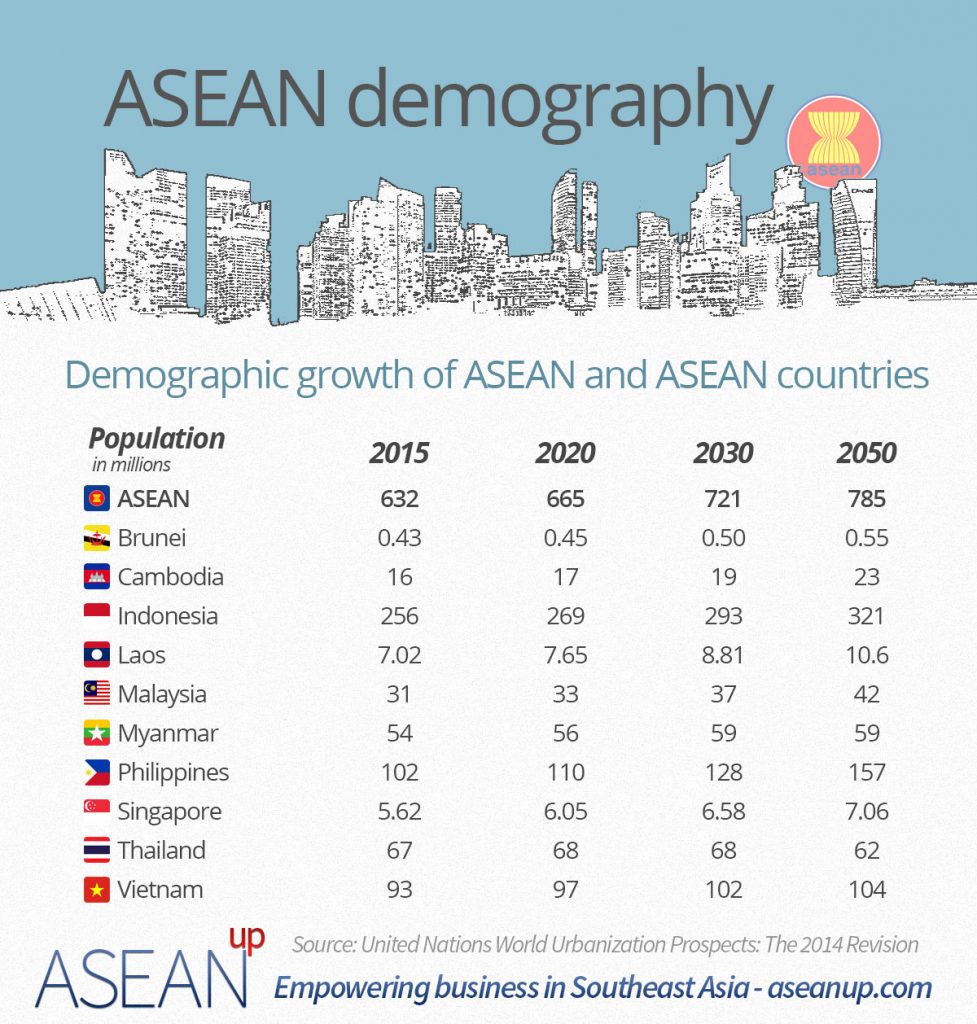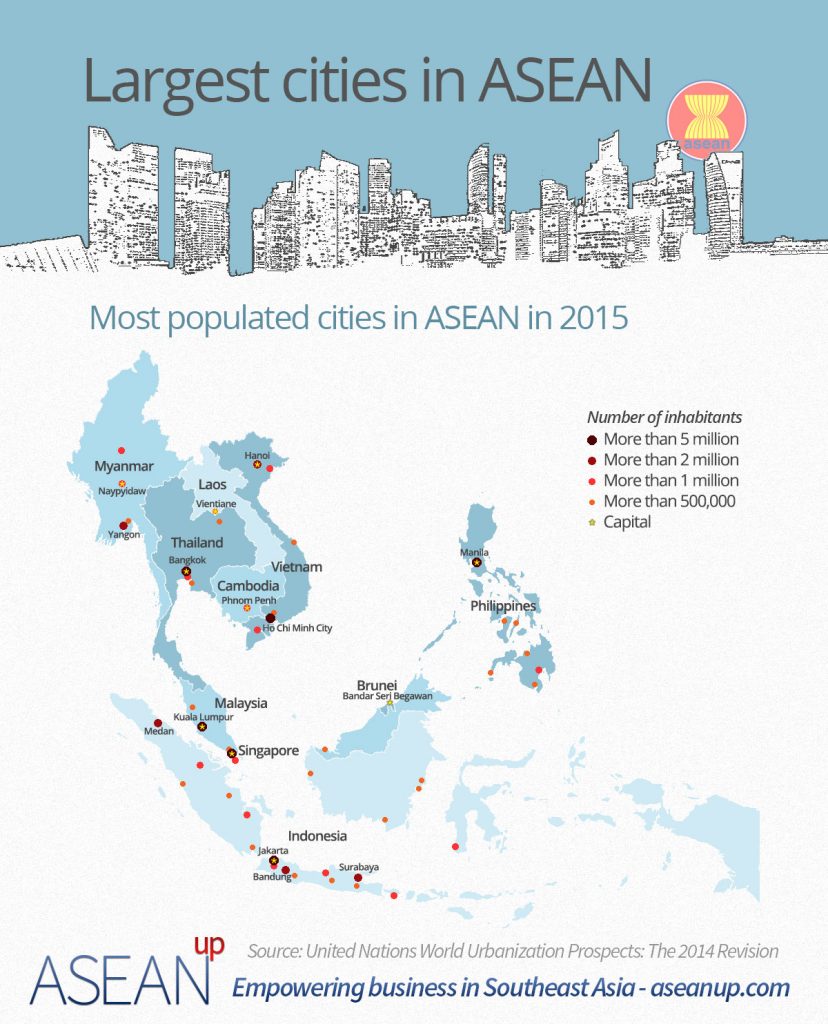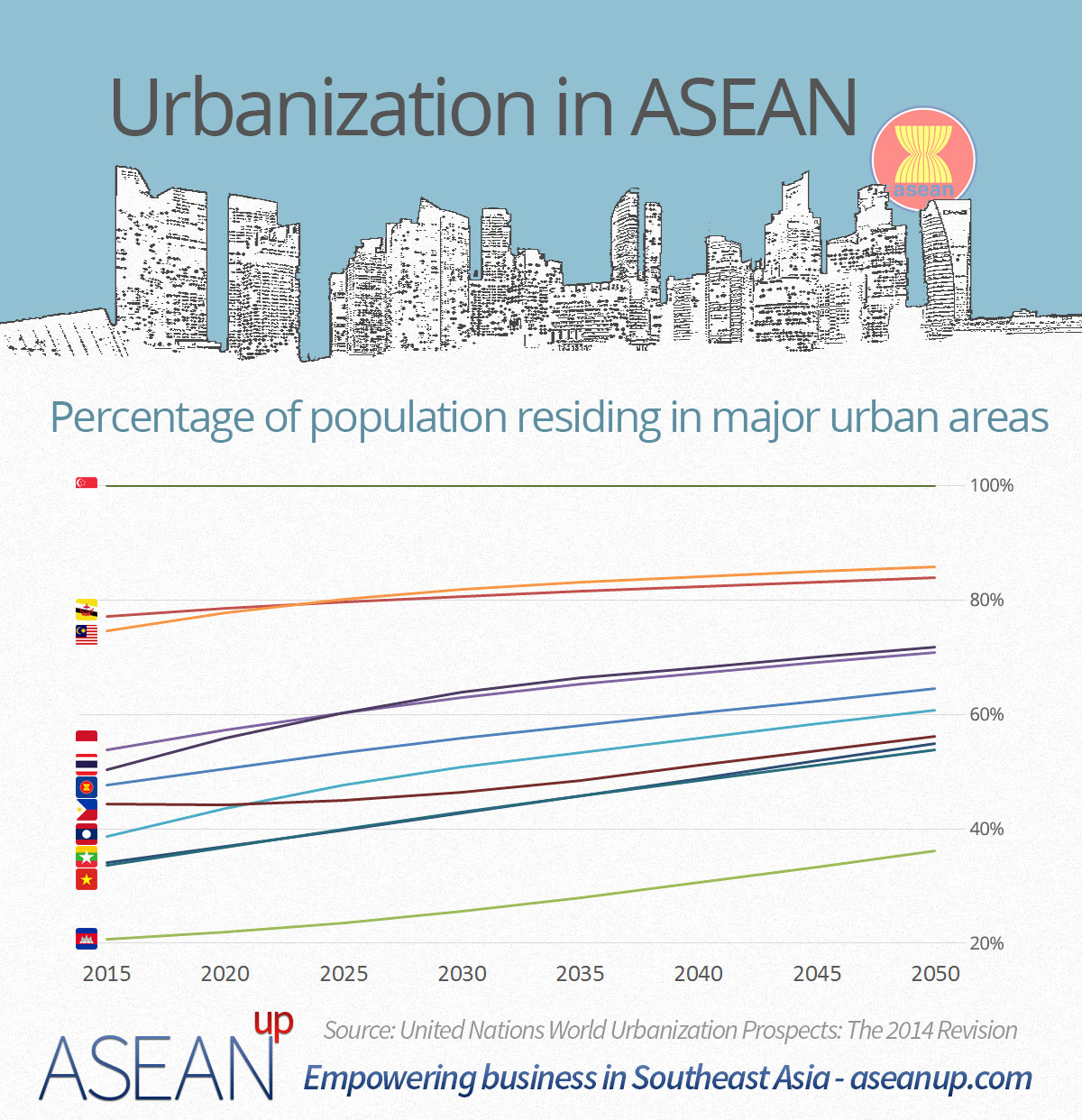Cities and urbanization are some of the most important drivers of Southeast Asia’s economic dynamism, environmental, societal and cultural change. To better understand the challenge and opportunities they bring, here are 4 infographics summarizing urban trends on the demography and rural exodus in ASEAN.
The following infographics present the data of the big “Top cities and urbanization in ASEAN infographic” with a focus on each of its main points: demography, urbanization, largest cities, fastest growing cities.
These infographics illustrate the key characteristics of cities and urbanization of Southeast Asia, as they are key forces that shape the future of ASEAN which will greatly impact its economy, especially construction, architecture, real estate, retail, transport, media… They were compiled from the data published in the United Nations World Urbanization Prospects.
You can freely use them to illustrate your ASEAN presentations, websites, blogs, illustrations, etc. However, if you do so, please create a link back to this page from your websites and blogs. Thank you!
ASEAN demography
This first infographic details the evolution of the population ASEAN and ASEAN countries in the coming years and decades. With very disparate countries and population ranging from less than half a million in Brunei to more than 250 million in Indonesia, Southeast Asia as a whole is poised to see a rapid demographic growth in most countries.

Embed code
The projections listed in this graph notably highlight the important demographic growth of ASEAN, from 630 million in 2015, to 660 million inhabitants in 2020, 720 million by 2030 and more 785 million by 2050. This growth will primarily be led by the population growth of Indonesia and the Philippines.
Urbanization in ASEAN
Southeast Asian countries also are very different from each other in terms of urbanization. But this diversity is a strength for the ASEAN region, as countries complement each other rather than competing heads on.

Embed code
With 100% urbanization in Singapore, Malaysia and Brunei are highly urbanized countries, before the bulk of fairly urban ASEAN countries, Indonesia, Thailand, Philippines, Laos, Myanmar and Vietnam, finally followed by Cambodia, which is still predominantly rural.
Geographical situation of the largest cities in Southeast Asia
The following map shows the geographical situation of the largest cities in Southeast Asia. With its population of more than 250 million inhabitants, Indonesia stands out with Jakarta, the second most populous city in ASEAN after Manila, Philippines, and several cities with more than a million inhabitants.

Embed code
Vietnam and the Philippines also have many large cities in a relatively small territory, while Thailand, Myanmar, Laos, Cambodia and the eastern islands of Indonesia present more sparsely inhabited areas.
List of largest and fastest growing cities in ASEAN
Several Southeast Asian cities are already among the most populated in the world. As of 2015, the top 10 largest ASEAN countries are:
- Manila (Philippines): 12.9 million
- Jakarta (Indonesia): 10.3 million
- Bangkok (Thailand): 9.3 million
- Ho Chi Minh City (Vietnam): 7.3 million
- Kuala Lumpur (Malaysia): 6.8 million
- Singapore: 5.6 million
- Yangon (Myanmar): 4.8 million
- Hanoi (Vietnam): 3.6 million
- Surabaya (Indonesia): 2.9 million
- Bandung (Indonesia): 2.5 million

Embed code
Though these megalopolises will keep on growing, the second-tier cities of Southeast Asia will experience the fastest growth, draining the neighboring areas through rural exodus. Many middle-sized cities, especially in Indonesia and Vietnam, are currently experiencing a demographic boom which will result in impressive growth by 2025.
- Samut Prakan (Thailand) will grow from 1.8 M inhabitants in 2015 to 2.9 M in 2025: +62.3% growth
- Batam (Indonesia), from 1.4 M to 2.2 M: +60.8%
- Vientiane (Laos), from 0.99 M to 1.6 M: +54.5%
- Denpasar (Indonesia), from: 1.1 M to 1.7 M: +51.9%
- Tasikmalaya (Indonesia), from: 0.78 M to 1.2 M: +48.7%
- Can Tho (Vietnam), from: 1.2 M to 1.7 M: +45.9%
- Pekan Baru (Indonesia), from: 1.1 M to 1.6 M: +38.8%
- Hanoi (Vietnam), from: 3.6 M to 5.0 M: +37.5%
- Samarinda (Indonesia), from: 0.86 M to 1.2 M: +33.9%
- Bien Hoa (Vietnam), from: 0.83 M to 1.1 M: +32.1%
- Hai Phong (Vietnam), from: 1.1 M to 1.4 M: +31.5%
- Phnom Penh (Cambodia), from: 1.7 M to 2.3 M: +30.7%
Here are the infographics, what do you think of them? Are they clear? Do they cover the main aspects of urbanization of the region? What do you think about the largest cities and fastest growing ones? Leave your comments below!



